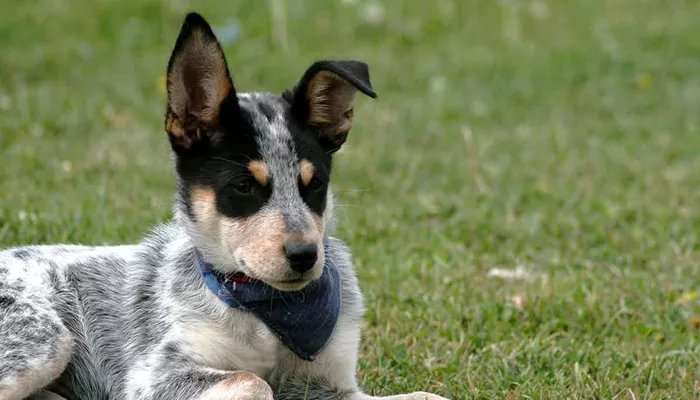The term “Heeler” refers to the Australian Cattle Dog, a breed known for its remarkable herding skills. Developed in the 19th century in Australia, Heelers were bred to handle the harsh conditions of cattle ranches. Their ancestry includes the Dingo (Australia’s wild dog), Collies, and Dalmatians, resulting in a tough, intelligent, and adaptable working dog.The name “Heeler” comes from their herding style: these dogs gently nip at the heels of cattle to guide them. This method is efficient and minimizes stress on the animals, making Heelers invaluable to ranchers.
Understanding the Heeler: Origins and History
Key Historical Milestones
1800s: Early settlers crossbred European herding dogs with Dingos for heat and terrain adaptability.
1893: Robert Kaleski, an Australian breeder, formalized the breed standard.
1980s: The American Kennel Club (AKC) officially recognized the Australian Cattle Dog.
Physical Traits: Identifying a Heeler
Heelers have a distinct appearance that sets them apart from other breeds.
Body Structure
Size: Medium-sized, standing 17–20 inches (43–51 cm) tall and weighing 30–50 pounds (14–23 kg).
Coat: A double coat with a short, dense undercoat and a weather-resistant outer layer. Colors include blue (with black or blue speckles) and red (with reddish speckles).
Markings: Many Heelers have a “mask” (dark fur around the eyes) or a “Bentley Mark” (a white spot on the forehead).
Facial Features
Eyes: Almond-shaped, dark brown, and highly expressive.
Ears: Prick ears that stand upright when alert.
Tail: Bushy and typically low-set, often with a white tip.
Personality and Behavior: Is a Heeler Right for You?
Heelers are loyal and energetic but require an experienced owner.
Core Temperament Traits
High Energy: Bred for work, Heelers need 1–2 hours of intense exercise daily. Without it, they may become destructive.
Intelligence: Ranked among the top 10 smartest dog breeds, they excel in obedience and agility training.
Loyalty: They form strong bonds with their families but can be wary of strangers.
Compatibility with Families
Active Households: Ideal for owners who enjoy hiking, running, or dog sports.
Children: Heelers can be good with kids if socialized early, but their herding instincts may lead to nipping.
Other Pets: They may chase smaller animals unless trained.
Health and Care: Keeping Your Heeler Healthy
Heelers are generally hardy but prone to certain health issues.
Common Health Problems
Hip Dysplasia: A genetic joint condition. Regular vet check-ups and weight management can help.
Deafness: Linked to the gene causing white coats. Breeders often test puppies for hearing issues.
Progressive Retinal Atrophy (PRA): A degenerative eye disease.
Daily Care Tips
Diet: High-quality protein-rich food to support their active lifestyle. Avoid overfeeding.
Exercise: Combine physical activities (fetch, running) with mental challenges (puzzle toys).
Grooming: Brush weekly to reduce shedding. Bathe only when necessary to preserve natural oils.
Training and Socialization: Building a Strong Bond
Heelers thrive with structured training and early socialization.
Training Strategies
Start Early: Begin obedience training at 8–10 weeks old.
Positive Reinforcement: Use treats, praise, or toys to reward good behavior.
Job Assignments: Give them “tasks” like carrying a backpack during walks to satisfy their work drive.
Addressing Behavioral Issues
Nipping: Redirect this instinct to toys or teach a “leave it” command.
Barking: Use commands like “quiet” and reward calm behavior.
Heelers vs. Other Herding Breeds
While Heelers share traits with other herding dogs, key differences exist:
| Feature | Australian Cattle Dog (Heeler) | Border Collie | Australian Shepherd |
|---|---|---|---|
| Herding Style | Nips heels | Stares and stalks | Circles and nudges |
| Energy Level | Extreme | Extreme | High |
| Coat Maintenance | Low | Moderate | High |
| Best For | Ranches/active homes | Farms/agility sports | Families/dog sports |
How to Identify a Heeler Using Technology
Modern tools like DNA tests (e.g., Embark, Wisdom Panel) or AI breed scanners can analyze your dog’s traits.
Steps for Breed Identification:
- Take clear photos of your dog’s face, body, and markings.
- Upload to an app like “Dog Scanner” or submit a DNA sample.
- Review the report for breed percentages and health insights.
Adopting a Heeler: What to Consider
Finding a Reputable Breeder
- Ask for health clearances (hips, eyes, hearing).
- Visit the breeding facility to assess living conditions.
Adoption Options
Rescues: Organizations like the Australian Cattle Dog Rescue Association specialize in Heelers.
Shelters: Check local shelters for mixes or purebreds needing homes.
Fun Facts About Heelers
Movie Stars: A Heeler named “Bluey” inspired the popular Australian children’s show.
Longevity: Heelers often live 12–16 years, longer than many medium-sized breeds.
Athletic Feats: They excel in dog sports like flyball, dock diving, and herding trials.
Conclusion
Heelers are more than working dogs—they’re loyal companions for those who match their energy and intelligence. With proper care, training, and love, a Heeler can become an irreplaceable member of your family.Always research breeders thoroughly or consider adopting. These dogs deserve owners committed to their physical and mental well-being.
Related Topics:
WHAT ARE THE CONS OF THE AUSTRALIAN TERRIER?
DO AUSTRALIAN TERRIERS NEED HAIRCUTS?
HOW TO TRIM AN AUSTRALIAN TERRIER


